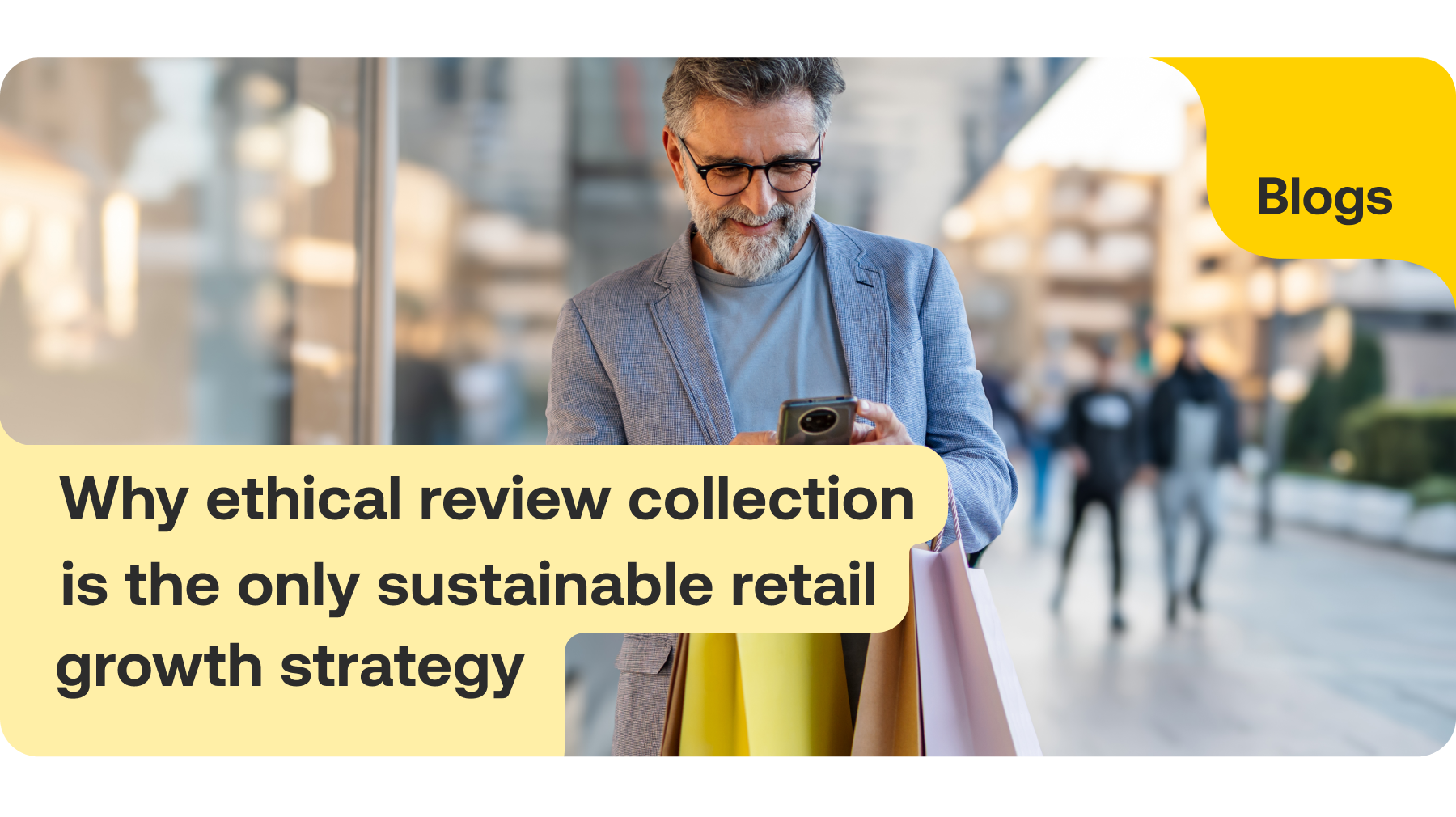What are the current consumer trends? Shopping habits, behaviour, and loyalty
UK consumers increasingly turn to fellow customers to learn more about a product or service, to help them decide whether to buy or walk away.
In the Feefo 2019 Consumer Report, we polled 2,000 UK consumers to find out more about their views on reviews, including how much they trust them and how they use them when shopping.
Here, we take a closer look at the results to find out more about shopping habits, consumer trends and how verified reviews can impact consumer purchasing decisions.
Shopping habits
How do people shop?
We found the use of mobile phones for online shopping has more than doubled since 2018, with 53% of consumers preferring to use their smartphone for shopping in 2019.
Smartphones have overtaken desktops and laptops as consumers’ favourite devices for shopping, with just 31% using a desktop or laptop to online shop in 2019.
We also found that:
- 64% of women use smartphones to research and shop online, compared with 41% of men
- 62% of 35 to 44-year-olds use smartphones for shopping and researching online, rising to 71% among 18 to 24-year-olds
- 42% of consumers research and buy a product or service online at home in 2019, up from 38% the previous year
- 8% of over-65s use smartphones to research and shop online, while 13% use a tablet.
Excluding bricks and mortar retail, we found consumers most frequently buy from retailer websites (37%) and online marketplaces such as eBay and Amazon (26%). Only 13% regularly use offer websites like Groupon, while just 9% regularly buy from social media adverts or links from influencers.
Top trends
We asked 2,000 UK consumers for their views on reviews, exploring the question of trust and how they use customer feedback. Here are the key trends we found:
- Smartphone use for researching and shopping has more than doubled but is more popular with women than men
- Reviews are as helpful as advice from friends and family and are used to explore quality, value for money, and hidden drawbacks of products or services
- Most people use star ratings in conjunction with reviews, very rarely relying on stars alone
- Younger consumers are more concerned about the personal profile of reviewers, but for the majority, it’s not a big concern
- Anonymous reviews are not popular
- Consumers are still worried about fake reviews, though slightly less than in previous years
- The absence of negative reviews makes consumers suspicious
- Consumers mostly post reviews for positive reasons.
What does this mean for brands?
Problems with fake reviews underline how vital it is for consumers to trust what they read. Shoppers need to access the real opinions of other customers rather than cherry-picked, uniformly positive reviews. Maximum transparency from businesses can lead to increased trust and loyalty, turning satisfied customers into brand advocates.
Why is customer loyalty important?
Reviews should be part of a brand’s strategy for building loyalty, but it’s hard when there’s so much choice online. Our survey found that customer loyalty is scarce.
36% said products and quality are reasons for staying with a brand, making them more influential than price (22%) or customer experience (15%). Consistency in service is only influential with 12%, while quirkiness or uniqueness counts with just 3% of consumers. Find out how to make surveys work for you.
Reviews
How important are reviews to consumers?
With reviews influencing £23 billion in annual UK consumer spending, retailers must recognise the significance of feedback in the overall customer journey. Almost all respondents (96%) in our research said they read or use reviews in some way when shopping.
What do consumers think of feedback and how do they use it?
80% of respondents found online reviews from other customers helpful, with the same number claiming that advice from friends and family is also useful. Women are more likely (84%) to say reviews are helpful than men (76%).
When we asked how consumers use feedback, we found that:
- 75% find price comparison websites helpful
- 73% use watchdog or trade recommendations
- 53% use press, broadcast or online media reviews
- 41% regard advice on social media as useful (rising to 53% among 18 to 24-year-olds)
- 29% follow the advice of social media influencers and celebrities.
Consumers read multiple reviews before purchasing certain products and services, including:
- TVs or laptops (57%)
- Holidays, flights and rail trips (45%)
- Cars and big one-off purchases (34%)
- Restaurants (25%)
- Kitchen appliances (23%)
- Clothes (18%)
- Furniture (16%)
- Cosmetics (12%).
What about star ratings?
Most respondents (67%) take both the content and the star rating into account when they use reviews. Just 8% look solely at star ratings and ignore review content.
Nearly three-quarters (74%) find star ratings helpful when deciding what to buy and 55% will not buy something that only has an overall star rating of one or two stars. There’s a notable difference between men and women – 80% of women find stars helpful, dropping to 68% of men.
However, not everyone trusts low star ratings, with 30% of consumers distrustful of one-star reviews because they think they’re unlikely to be accurate. This was truer of men (35%) than women (26%).
Whose review is it?
For most people (60%), the age and background of reviewers is unimportant. However, more than two-thirds (67%) say they care whether reviewers are named and 44% only trust named contributors. Suspicions also arise if the tone of reviews is almost uniformly positive.
More than half of consumers (52%) are suspicious if there are no negative reviews of the product or service they’re considering purchasing. This is especially true among the over-65s (65%). The older the consumer, the more likely they are not to trust anonymous reviews.
Why and when do people leave reviews?
Our research found that most of the time, consumers contribute review feedback for positive reasons. 61% left reviews to rate good customer service and 58% offered feedback based on great product quality.
Reasons for leaving a negative review included:
- 47% for poor service
- 36% for poor quality product
- 28% unhappy with the price
- 14% disagree with other reviews.
We also found that those aged 18-24 are most likely (56%) to leave a review about poor service.
We asked our respondents how often they give their feedback, with the following responses:
- 31% post ‘sometimes’
- 25% leave reviews ‘most of the time’
- 22% rarely or never post feedback
- 11% post a review every time.
Consumers are most likely to say they never post reviews because it’s a waste of their time (56%). More men (65%) take this view than women (45%).
Around 1 in 2 consumers don’t post because it takes too long or there are too many questions. Streamlining the review process can improve this figure, however loss of faith that anything will change should also be taken into consideration. Only 39% of consumers think retailers take review feedback into account, while another 39% are unsure and 22% don’t believe it ever happens.
Negative reviews
Why is negative feedback important?
We know how important reviews are, but what do consumers think of negative feedback and how do they use it?
We found that more than half (52%) of consumers are suspicious if there are no negative reviews, especially among the over-65s (65%). Almost three-quarters of all consumers (72%) read several negative reviews to see if they cover the same issue.
While almost a fifth of all respondents (19%) read negative reviews first, only 23% claimed that a single bad review would completely discourage them from buying something, even if most reviews were positive.
How to respond to negative reviews
While no one likes to receive negative feedback, businesses can learn a lot from customers who weren’t entirely satisfied with their experience. We found that 69% of consumers said that they’d continue to make a purchase if they could see that a company had acknowledged a poor review, apologised and offered a solution. Read our handy guide to find out how to respond to negative reviews.
Fake reviews
Although most consumers (72%) are worried about fake reviews, this is down from 89% in 2018. Nonetheless, consumers understand the value of verified reviews, with 50% more likely to trust a brand if reviews are authenticated by a reputable third-party feedback platform like Feefo. Among our respondents, we found that:
- 49% trust reviews if they are detailed
- 40% want them to sound genuine and be verified
- 38% have more trust in a review if a picture of the product is included
- 23% never trust anonymous reviews.
How can Feefo help?
Providing great customer experience is now fundamental to the success of every retailer. As our research shows, reviews from real customers have become an essential tool in crafting the perfect customer journey.
Consumers want authenticity and transparency when it comes to reviews, with the majority still worried about fake feedback. Feefo has long been at the forefront of efforts to eliminate fake reviews, which is why we only publish reviews from real customers who are invited to share their feedback.



